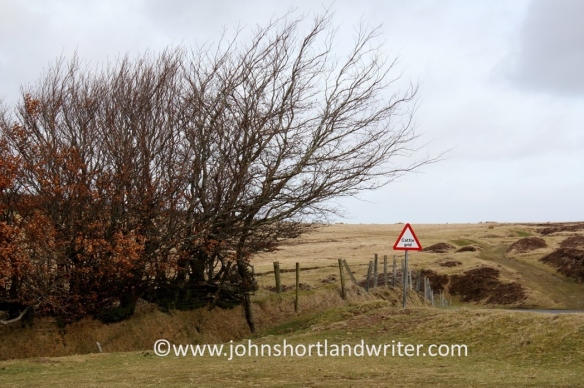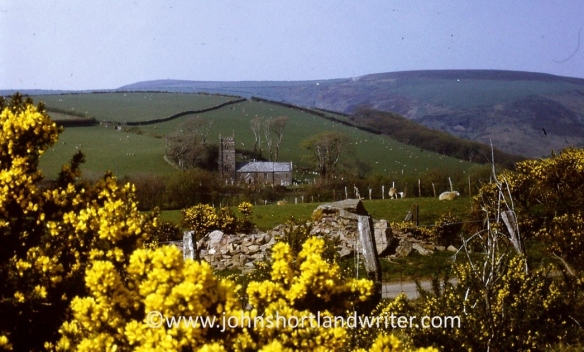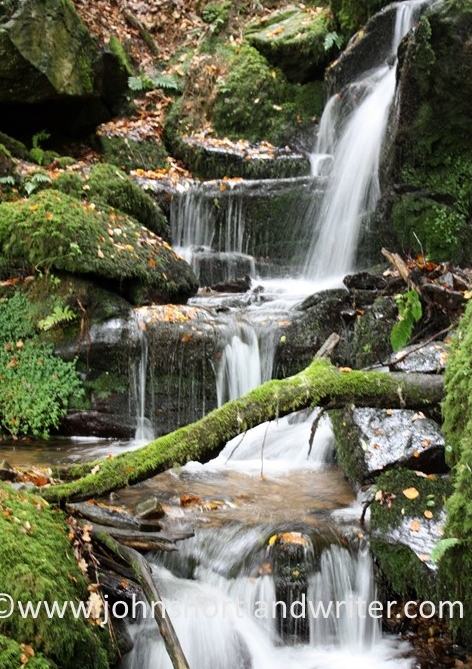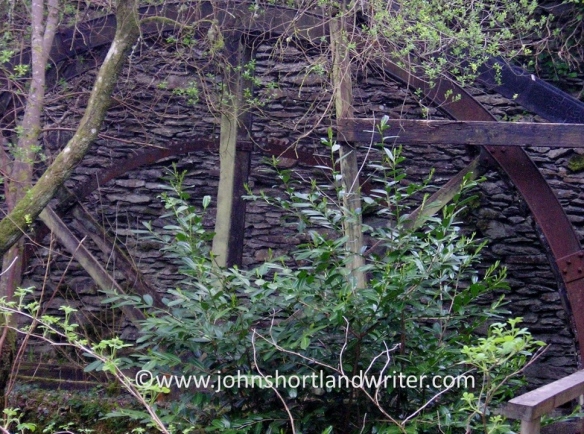I have misgivings about sharing this walk for it is a favourite of mine: in the 48 years that I have known it I have rarely met anyone other than those that work the land here. Do I want to encourage others to discover its beauty? I’m not sure.
This circular walk begins with the open expanses of Brendon Common but follows more sheltered winding lanes before descending through beech woodland to Rockford and the East Lyn River. A steep climb past Brendon church returns you to the moor. How long does it take? There’s no easy answer to this – allow two hours although experience tells me there are so many distractions along the way, including the Rockford Inn, that it can take much, much longer. Whether you want a quick sprint or a leisurely amble good supportive footwear is essential as is the ability to climb hefty hills.

Brendon Common
There is plentiful parking at Scobhill Gate, the cattle grid on the B3223 that denotes the westernmost boundary of Brendon Common. From here walks radiate across the 2000 acres of heather moorland but our route takes us over the cattle grid into farmed country and turns right by the hairpin bends at Brendon Manor Stables.

Scobhill Gate
After a few hundred yards the road, which is flanked by hedges of hazel, ash, furze, bramble and bilberry (known locally as wurts), meets Gratton Lane. This is very much ‘home’ territory for me, for it is here at Brendon Barton that I arrived as a lad to work and play in 1968. Opposite the farm there are fine views of Brendon church and in the far distance Countisbury Common and the sea.

Brendon Barton 1968

Walking along Gratton Lane is lovely at any time of the year but is at its best in spring when the beech hedges are bursting into leaf and primroses and bluebells nestle at their feet. These banks are an ancient method of providing shelter, as well as a barrier to livestock, from the fierce gales and snowstorms that sweep in from the Atlantic. The banks stand about five feet in height, lined with stone with the beech planted above.

Gratton Lane
Just as the lane starts to descend it enters woodland and it is here – just past the warning sign denoting the ford that crosses the road – that a footpath is taken to the left. The path follows a pretty stream as it tumbles over rocks down to join the East Lyn River. It is here that the unwary walker can also take a tumble as the path crosses outcrops of rock that become quite slippery when damp. This stream has everything a larger one would have – cascades, waterslides, ferns growing from niches – but all in miniature. Despite its diminutive size it once powered a sawmill.
The mill has long been a ruin and is now fenced for safety but the rusting ironwork is still visible. Just beyond the old building the path joins the road. Turn left and follow the lane to the hamlet of Rockford. You are now walking in the Brendon valley with its beechwoods clinging to the steep hills high above, home to a number of rare rowan trees (Sorbus) unique to the area. The East Lyn River is a major river; when water levels are low it is difficult to imagine its ferocity when in spate. In 1952 it destroyed bridges, houses and lives as it passed through the valley culminating in the flood disaster at Lynmouth where thirty-four people lost their lives and over one hundred houses were destroyed. The Rockford Inn is a good place to stop for a beer; they also serve cream teas. Just make sure that you put the cream on the scone before the jam in the Exmoor tradition! It is possible to extend the walk to Watersmeet (where there is a National Trust tearoom) by crossing the river.

The Old Mill nr Rockford

East Lyn River
Once past Rockford the road starts to climb until it reaches Brendon church. The hill is a killer – it’s not called Church Steep for nothing! The church which nestles into the hill and looks out across the combes looks as if it has been there for centuries. In reality, it was moved stone by stone from nearby Cheriton in 1738. It is simply decorated inside but has some attractive stained glass. Brendon Barton, passed earlier, can be seen from the steps of the church. Follow the lane back to the farm; from there retrace the original route back to Scobhill Gate.


Brendon Barton, view from the church
Happy walking!
Exmoor is a National Park in the southwest of England and straddles the counties of Devon and Somerset. Apart from miles of wonderful moorland walks, it also has the highest sea cliffs in England, pretty villages and spectacular wildlife including the majestic Red Deer. Native Exmoor ponies roam the open moor. Now a rare breed they remain virtually unchanged from pre-history.







































 .
.
 .
. .
. .
. .
. .
. .
. Now people get very excited by upturning the flowerhead so they can see a slightly larger speck of green on the bloom or scrabbling about on their knees in search of the single rarity that lurks amongst the ordinary – and good luck to them. Call me boring or unimaginative if you want but just give me bog standard Galanthus nivalis any day – preferably in their thousands. This really is a case where more is best as the carpets of snowdrops that flower in the garden of the house that was built for me two hundred years ago proves. (Readers of this blog may remember the
Now people get very excited by upturning the flowerhead so they can see a slightly larger speck of green on the bloom or scrabbling about on their knees in search of the single rarity that lurks amongst the ordinary – and good luck to them. Call me boring or unimaginative if you want but just give me bog standard Galanthus nivalis any day – preferably in their thousands. This really is a case where more is best as the carpets of snowdrops that flower in the garden of the house that was built for me two hundred years ago proves. (Readers of this blog may remember the 
 Well, yes, there could be. My death next time round should be marked with the Winter Aconite, Eranthis hyemalis. There is something very cheering and positive about their bright yellow, perhaps it is because we crave some strong colour after a long winter. It is the same shade as the yellow daffodils and also of forsythia. By the time these have finished, weeks later, we are fed up with it and find it all rather garish. But in January we start to notice the little ruffs of green leaves pushing through the ground and, quite suddenly, the flower is opening its blooms. I hadn’t noticed before just how similar the individual flowers are to a buttercup when fully open. Not surprising really, as they all belong to the same family, Ranunculaceae. The aconite, I assume, is so-named beacause of the similarity of the leaf with the tall herbaceous aconites, Aconitum.
Well, yes, there could be. My death next time round should be marked with the Winter Aconite, Eranthis hyemalis. There is something very cheering and positive about their bright yellow, perhaps it is because we crave some strong colour after a long winter. It is the same shade as the yellow daffodils and also of forsythia. By the time these have finished, weeks later, we are fed up with it and find it all rather garish. But in January we start to notice the little ruffs of green leaves pushing through the ground and, quite suddenly, the flower is opening its blooms. I hadn’t noticed before just how similar the individual flowers are to a buttercup when fully open. Not surprising really, as they all belong to the same family, Ranunculaceae. The aconite, I assume, is so-named beacause of the similarity of the leaf with the tall herbaceous aconites, Aconitum.

 Neither snowdrops or aconites are native to the British Isles although both naturalise well and, given time, will occupy large areas. Conditions in this country must favour the snowdrop for snowdrop woods, whilst not common, are found with relative ease and are nearly always associated with a large country house. A much greater rarity is the aconite wood and I know of only one and heard of only one other. To visit it is an extraordinary experience for it is difficult to walk through the tens of thousands of plants that carpet the ground. This wood is also attached to a country estate but rarely visited and away from public paths. Perhaps that is why it has survived.
Neither snowdrops or aconites are native to the British Isles although both naturalise well and, given time, will occupy large areas. Conditions in this country must favour the snowdrop for snowdrop woods, whilst not common, are found with relative ease and are nearly always associated with a large country house. A much greater rarity is the aconite wood and I know of only one and heard of only one other. To visit it is an extraordinary experience for it is difficult to walk through the tens of thousands of plants that carpet the ground. This wood is also attached to a country estate but rarely visited and away from public paths. Perhaps that is why it has survived.